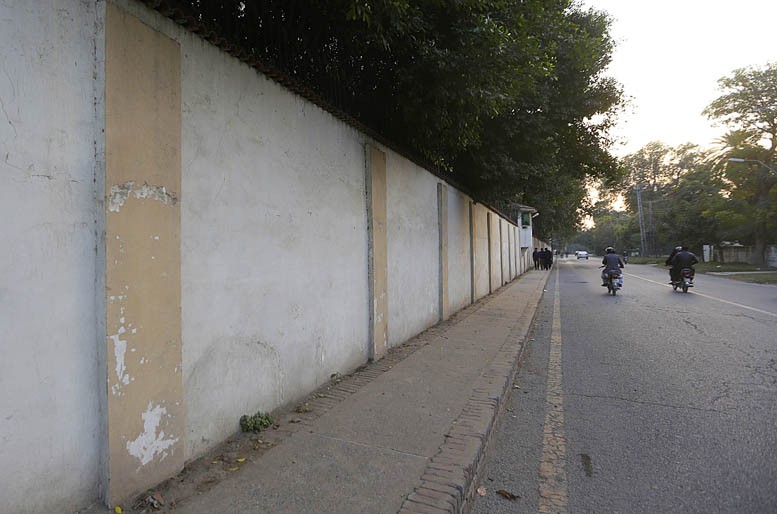
The Punjab government’s move to demolish the boundary wall of the Governor’s House may have been stayed by the LHC, it has sparked off a debate between those in favour of a "visually permeable fence," and those citing laws to protect heritage sites from any alteration

The old and apparently abandoned heritage sites which once stood proudly in the city of Lahore have slowly been consumed by modern-day eyesores. These buildings have been exposed to a process of wrecking the city’s urban legacy, a process which can be dubbed as the forced rejection of memories that were once dear to us. It seems like the wounds of demolition history inflicted on us will never heal as the city’s signature canvas of old landmarks is constantly fighting a losing battle against the criminal apathy towards heritage.
The latest brouhaha around the plans to raze down the walls of the Governor’s House, Punjab, may not have attracted the citizens’ attention as many urban planners would have wanted it to but has engaged the judiciary and the government in what seems like an endless debate on the ‘right course of action’.
Earlier this month, in a hasty move the government of Punjab, following Prime Minister Imran Khan’s orders, started demolishing the boundary wall of the Governor’s House. Many thought that the order was a knee-jerk reaction on the part of the PTI-led government, as a follow-up to PM’s promise of turning the Prime Minister’s House as well as Governor’s Houses into public spaces in his first address to the nation. Similarly, the official spokesperson of the Punjab government, Fayyaz Ul Hassan Chohan, put a dramatic spin on the decision by announcing in a press conference that "the (Governor’s House) walls were there to strike fear in the hearts of people."
The (government’s) move was soon halted with a stay order from the Lahore High Court (LHC) by Justice Mamoon-ur-Rashid who had heard the initial arguments in a petition against demolition of the wall. Later, the logic behind the move was defended by the PM while interacting with journalists -- the wall of the Governor’s House is "a symbol of slavery," he said, adding that the PTI government was "here to demolish that."
Marred by controversy, the decision has been equally criticised by people calling it wasteful spending in times of austerity, and a potential threat to the gubernatorial office after the wall is replaced with a visually permeable iron fence.
Rabia Ezdi, Associate Professor, Department of Architecture, National College of Arts, Lahore, thinks otherwise. "One of the principles of good urban design is visual permeability, or in the words of celebrated urbanist Jane Jacobs, ‘eyes on the space’," she tells TNS. "This means that the more visually transparent a public space is, the more secure it will be, as it is undergoing constant surveillance by those using it and those looking into it."
With fast shrinking open spaces within Lahore, Ezdi believes that opening up the lawns of the building to the public would definitely contribute to making the city more inclusive -- a step towards fulfilling the Sustainable Development Goal 11 to make "cities and human settlements inclusive, safe, resilient and sustainable. In times of relative normalcy (from the ‘terrorist threat’ point of view), making the walls of the Governor’s House visually permeable will most likely not compromise its security, especially if the greens of the place are opened for use as public space," she adds.
"Secondly, in psychological terms, for citizens in general, greater and more dignified accessibility to public space adds to a stronger sense of citizenship and ownership."
Renowned architect and founding member of the Lahore Bachao Tehreek, Kamil Khan Mumtaz says that he finds no rhyme or reason in the decision taken by the government. According to him, the Governor’s House is protected under different heritage laws that clearly state that no part of the building could be demolished or altered.
"There are many aspects to the situation," he says. "First is the legal aspect in the form of the Punjab Special Premises (Preservation) Ordinance, 1985, which is quite clear that no work could be carried out within the premises of the protected monument. It also mentions that no work can be carried out within a space of 200 feet of the special zone known as the ‘Zone of influence’ around the premises. So, without fulfilling all legalities the government should not act on someone’s whims."
Moreover, the Punjab Special Premises (Preservation) Ordinance, 1985, Section 14(1) clearly states that "Whoever contravenes the provisions of the ordinance or the rules shall be liable to imprisonment which may extend to one year or with fine or with both."
Mumtaz is of the view that the decisions made in haste are sometimes misquoted as popular ones, misguiding the citizens: "Having a consolidated plan requires input from various walks of life, and the government should understand that instead of embarking on a solo flight all voices should not only be heard but also assessed."
The final decision will now be made by the Lahore High Court after hearing arguments from all sides, a process which should have been taken into consideration by the Punjab government earlier on. Until then, the 700 kanals of land awaits its fate.
Whether it is restarted or abandoned altogether, the process of inflicting wounds on the already broken city is likely to continue.